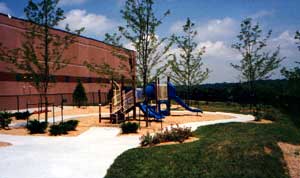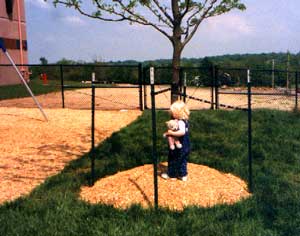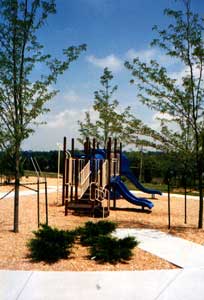
Vol. 6, Issue 1, Spring 2002
|
Download
or print our newsletter in
|
Index
- How Long Does Outdoor Design Take?
- Recent Projects
- Presentations
- Learning eNewsletter
- Who We Are and What We Do
How Long Does Outdoor Design Take?
I often find in working with early childhood professionals that there is a misunderstanding of how complicated it is and long it takes to develop a design for an outdoor play space for an early childhood facility. Good design is a process, and as such, requires time to evolve. In some instances, when a new center is being developed, the owners have not even started to look at the outdoor space until the interior space is completed. Waiting until the last minute to complete the outdoor space can create design constraints and undesirable outcomes such as having the play yard on the wrong side of the building for shade, having too little space left for the outdoor environment, not allowing enough time for the design process or creating poor adjacencies between the classrooms and the outdoor spaces. The design process can take as little as 10 weeks to as long as 4 months depending on the complexity of the project. Understanding the steps involved in the process will help you to understand how complicated and long the process is.
Identifying values and goals is the first step every program should take in designing outdoor play areas. It is important to look at the outdoor play and learning environment as one piece of the curriculum approach you are using to help children develop an appreciation of nature and to allow them opportunities to develop through play. Before approaching a renovation or construction project, you need to look at what the goals are for your program for nature education, both inside and outside, and how teachers are trained and supported in reaching these goals. You can build a naturalized outdoor play environment, but if teachers are not trained in how to model an interest or concern for the environment or prepared to build a curriculum around it, much of the opportunity will be lost. A visit from a good consultant/designer can help you in clarifying your goals.
In order to determine if your potential site is suitable to be used as a naturalized play area, a site visit is necessary by a consultant. This can be scheduled at the same time that the consultant assists you in clarifying your goals. Whether evaluating an existing site for renovation, a pre-selected site for new construction or choosing from several sites for future development, the process of site evaluation and analysis is the same.

Plants can create space for socialization.
A thorough inventory will need to be made of the location, site function, and infrastructure such as drainage, existing land features, topography, drainage and natural features. A site survey that includes all the existing features, improvements, vegetation, easements and setbacks will need to be made available to the consultant. If such a survey does not currently exist, the center would be responsible for hiring a local surveyor to prepare a site survey prior to commencing any design work.
During the initial site visit, the consultant/designer will inventory and take photos of existing plants, trees and shrubs. Notations will be made of how much sunlight and shade your play area receives, how the site relates to the indoor classrooms and how the site fits into the existing neighborhood. Drainage issues will be evaluated through the topographic plan. Play areas that ignore drainage and grading issues in their design often end up with pooling water and muddy areas, making them unsuitable for extended periods of time. Topographic plans are also needed to design a site that meets the access and maximum slope requirements of the American's with Disabilities Act.
After the site has been inventoried and analyzed, there are still many elements to consider in designing the area. This will include looking at the basic dimensions of spatial design such as scale, proportion, balance, rhythm, focal point and enclosure. Since a play space for children is a complicated design task, the following criteria will also need to be evaluated:
- Outdoor Users. What are the ages and numbers of children using the space? How are parents and staff going to use the space?
- Time of Use. Is it a half-day or full-day program?
- Use of Nature and Equipment. What are the goals you wish to achieve in the outdoor space and can this be accomplished with all natural elements or is some manufactured equipment also needed? If manufactured equipment is needed, add an additional 4-6 weeks for ordering equipment onto your construction schedule once the schematic design documents are completed.
- Accessibility. Is the play yard accessible to children, staff and parents with disabilities? How will the space meet the new Americans with Disabilities Act for outdoor play areas? Will the features truly be usable by children with disabilities?
- Equipment. If you hope to reuse older equipment in a renovation, does it meet the current Consumer Product Safety Commission's Guidelines for Public Playground Safety, the American Society for Testing and Materials Standards, the Americans with Disabilities Act for outdoor play areas and state licensing requirements? Is it more appropriate to use wooden, metal or recycled wood-plastic composite equipment?
- Supervision. Who will be supervising the children for outdoor time? How are they or will they be trained?
- Storage. Where will you store the loose outdoor play equipment and maintenance equipment?
- Security. Is vandalism a problem in your neighborhood?
- Shade. How should the play areas be positioned to utilize shade from buildings and vegetation? Will there be adequate shade or is additional shade needed?
- Compliance. Can the play space meet the local licensing requirements, fire codes that relate to evacuation of children and health regulations?
Once the design work has started, the consultant/designer will continue to evaluate the site for additional design criteria, including:
- Safety
- Safe and progressive challenge
- Diversity
- Range of challenges
- Seasonal changes
- Flexibility
- Permanence
- Year-round use
- Social interaction
- Balance of passive and active play
- Variety of socialization areas
- Variety of spatial and sensory experiences
- Private areas
- Separation and zoning of activities
- Wildlife habitat
- Child-staff interaction
- Indoor-outdoor relationships
- Maintenance

Have you hugged a tree today?
The designer will then prepare a conceptual plan for your study and approval. This phase of the design is the point at which changes are made. Once the client and the designer agree upon any modifications, final schematic design documents will be prepared. If necessary, construction documents can then be developed based upon the schematic design documents.
The project can then be put out to bid. Once you receive an acceptable bid, construction can then begin. The process of completing your outdoor play area is complex and requires time for the process to unfold. Planning ahead for the renovation or creation of a new outdoor space will assure that you get best and most effective design for your outdoor area.
Recent Projects
TLC Learning Center, Darien, IL
Provided consultation and technical assistance to this center on the possibility of expansion and the creation of new outdoor space.
Easter Seals Oklahoma, Oklahoma City, OK
Met with teachers and provided technical assistance on the renovation of an outdoor play space into a play garden. This center serves children with disabilities, so creating designs and equipment that included all children was needed.
Better Bodies Fitness Center, Ft. Mitchell, KY
Preparing design documents and specifying equipment for renovation and expansion of large drop-in child care facility to serve children from 6 weeks to 12 years in this established fitness center.
Center for Children's Services, Danville, IL
Met with teachers and provided technical assistance on the renovation of an outdoor play area for children ages 3 through 12.
Davis' Farmland, Sterling, MA
Provided the final construction documents for a large children's adventure play garden which includes a water sprayground, dinosaur dig, hiding huts, a maze, peddle go-karts, and unique climbing equipment including a cow-themed climber. Both the garden and the sprayground have separate areas for infants and toddlers. This is the seventh year that White Hutchinson has worked with this children's discovery farm to expand their business.
Putter's Paradise, Lee's Summit, MO
Developing final construction documents and equipment specifications for a large children's discovery center that includes an art studio, pretend supermarket, pretend restaurant, pretend house, pretend dress-up, water tables, face painting, miniature play, cooking for children, a performance area and separate area for infants and toddlers. A 20,000 square foot children's adventure garden is being designed created outdoors that includes pretend fishing, campfire cooking, hiding huts, climbing ropes, a custom climbing wall, peddle go karts, construction area, play stream, a performance area, a demonstration garden and a separate garden for infants and toddlers. Both the interior and garden will meet the needs of children ages 6 weeks to eight years old and includes mostly custom designed equipment.
How To Select A Designer for Your Play Garden
Unlike traditional playgrounds, where one piece of brightly colored, manufactured play equipment is pretty much the same as the next, discovery play gardens take specialized knowledge to design. The designer must take into consideration the people and land form, the plant and animal life and the types of play that are to be located in the space.

Play Garden Design by
White Hutchinson
The people involved in designing traditional playgrounds are not an appropriate choice for designing discovery play gardens. Landscape architects generally lack the specialized expertise needed, especially the knowledge of child development and how children use plants. Equipment manufacturers are not trained to design a naturalized outdoor play space. It is difficult for them to design a space that will use less of their traditional equipment, since their best interest is served by maximizing the amount of equipment they sell you.
When choosing your designer, be sure to ask for references and a list of other projects that the firm has created that is similar to a play garden. Don't be afraid to check references or ask for photos of previous work. Good design is vital and choosing the right designer will mean you will end up with a well-designed and quality outdoor play garden.
Presentations
- Ohio Association for the Education of Young Children, "Designing and Renovating Outdoor Play Spaces Using Nature as the Play Element", Columbus, OH, April 2002.
- Ohio Association for the Education of Young Children, "Renovating or Constructing Indoor Spaces to Meet the Needs of Infants, Toddlers and Preschool Children", Columbus, OH, April 2002.
- The Center for Early Childhood Leadership, Outdoor Play Environments, Wheeling, IL, September, 2002.
- Illinois Association for the Education of Young Children, "Designing and Renovating Outdoor Playgrounds Using Nature as the Play Element", Springfield, IL, October, 2002.
- Missouri Association for the Education of Young Children, "Designing
and Renovating Outdoor Playgrounds Using Nature as the Play Element",
Osage Beach, MO, October, 2002.
Learning eNewsletter
We now publish a Learning eNewsletter via e-mail every month or so. It contains topical information, just like this printed newsletter. If you are not currently receiving our Learning eNewsletter, you can subscribe here.
Who We Are and What We Do
White Hutchinson Leisure & Learning Group is a consulting and design firm that assists new or existing facilities in designing both indoor and outdoor environments for children. We are different from other design firms in that we use a team of experienced, child-oriented group of professionals to design and oversee the development of our construction or renovation projects. Our team is uniquely structured and includes more than just an architect and landscape architect. Our team also includes members with specialized expertise in child care, Head Start, early childhood education and the design of children's environments.
Our custom services include:
- Economic feasibility and funding consulting
- Preparation of start-up and operating budgets
- Full scale building design and construction documents
- Complete building renovation/construction documents
- Complete outdoor design and construction documents
- Equipment selection for start-up
- Training on the use of nature-based outdoor areas
Please let us assist you in creating outdoor environments and buildings which truly meet the needs of children, staff, parents and the community. Vicki L. Stoecklin, our Education and Child Development Director, has a master's degree, twenty-four years of diversified experience in Early Childhood Education and specialized training in infant and toddler care. She would love to hear about your program. Vicki can be reached by phone or by e-mail.

